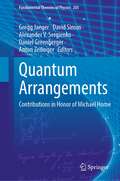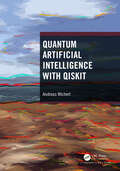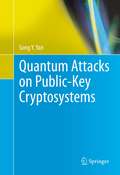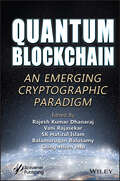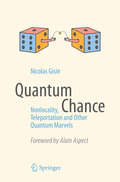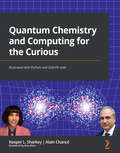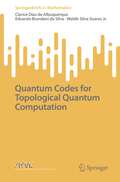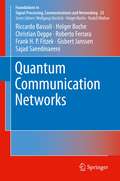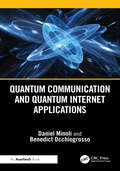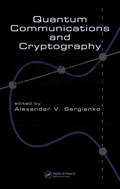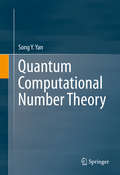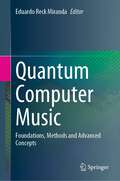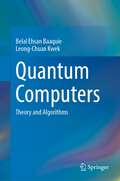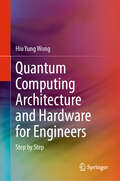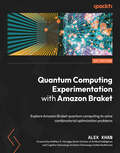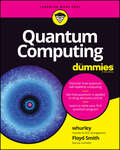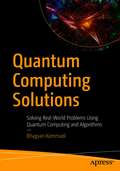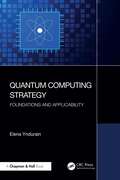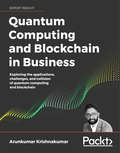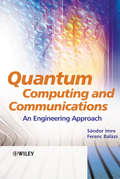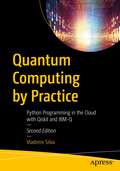- Table View
- List View
Quantum Arrangements: Contributions in Honor of Michael Horne (Fundamental Theories of Physics #203)
by David Simon Gregg Jaeger Anton Zeilinger Alexander V. Sergienko Daniel GreenbergerThis book presents a collection of novel contributions and reviews by renowned researchers in the foundations of quantum physics, quantum optics, and neutron physics. It is published in honor of Michael Horne, whose exceptionally clear and groundbreaking work in the foundations of quantum mechanics and interferometry, both of photons and of neutrons, has provided penetrating insight into the implications of modern physics for our understanding of the physical world. He is perhaps best known for the Clauser-Horne-Shimony-Holt (CHSH) inequality. This collection includes an oral history of Michael Horne's contributions to the foundations of physics and his connections to other eminent figures in the history of the subject, among them Clifford Shull and Abner Shimony.
Quantum Artificial Intelligence with Qiskit
by Andreas WichertQuantum Artificial Intelligence (QAI) is a new interdisciplinary research field that combines quantum computing with Artificial Intelligence (AI), aiming to use the unique properties of quantum computers to enhance the capabilities of AI systems. Quantum Artificial Intelligence with Qiskit provides a cohesive overview of the field of QAI, providing the tools for readers to create and manipulate quantum programs on devices as accessible as a laptop computer. Introducing symbolical quantum algorithms, sub-symbolical quantum algorithms, and quantum Machine Learning (ML) algorithms, this book explains each process step by step with associated Qiskit listings. All examples are additionally available for download at https://github.com/andrzejwichert/qai. Allowing readers to learn the basic concepts of quantum computing on their home computers, this book is accessible to both the general readership as well as students and instructors of courses relating to computer science and AI.
Quantum Attacks on Public-Key Cryptosystems
by Song Y. YanThe cryptosystems based on the Integer Factorization Problem (IFP), the Discrete Logarithm Problem (DLP) and the Elliptic Curve Discrete Logarithm Problem (ECDLP) are essentially the only three types of practical public-key cryptosystems in use. The security of these cryptosystems relies heavily on these three infeasible problems, as no polynomial-time algorithms exist for them so far. However, polynomial-time quantum algorithms for IFP, DLP and ECDLP do exist, provided that a practical quantum computer exists. Quantum Attacks on Public-Key Cryptosystems presemts almost all known quantum computing based attacks on public-key cryptosystems, with an emphasis on quantum algorithms for IFP, DLP, and ECDLP. It also discusses some quantum resistant cryptosystems to replace the IFP, DLP and ECDLP based cryptosystems. This book is intended to be used either as a graduate text in computing, communications and mathematics, or as a basic reference in the field.
Quantum Blockchain: An Emerging Cryptographic Paradigm
by Ching-Hsien Hsu Balamurugan Balusamy Sk Hafizul Islam Rajesh Kumar Dhanaraj Vani RajasekarQUANTUM BLOCKCHAIN While addressing the security challenges and threats in blockchain, this book is also an introduction to quantum cryptography for engineering researchers and students in the realm of information security. Quantum cryptography is the science of exploiting quantum mechanical properties to perform cryptographic tasks. By utilizing unique quantum features of nature, quantum cryptography methods offer everlasting security. The applicability of quantum cryptography is explored in this book. It describes the state-of-the-art of quantum blockchain techniques and sketches how they can be implemented in standard communication infrastructure. Highlighting a wide range of topics such as quantum cryptography, quantum blockchain, post-quantum blockchain, and quantum blockchain in Industry 4.0, this book also provides the future research directions of quantum blockchain in terms of quantum resilience, data management, privacy issues, sustainability, scalability, and quantum blockchain interoperability. Above all, it explains the mathematical ideas that underpin the methods of post-quantum cryptography security. Readers will find in this book a comprehensiveness of the subject including: The key principles of quantum computation that solve the factoring issue. A discussion of a variety of potential post-quantum public-key encryption and digital signature techniques. Explanations of quantum blockchain in cybersecurity, healthcare, and Industry 4.0. Audience The book is for security analysts, data scientists, vulnerability analysts, professionals, academicians, researchers, industrialists, and students working in the fields of (quantum) blockchain, cybersecurity, cryptography, and artificial intelligence with regard to smart cities and Internet of Things.
Quantum Chance: Nonlocality, Teleportation and Other Quantum Marvels
by Nicolas GisinQuantum physics, which offers an explanation of the world on the smallest scale, has fundamental implications that pose a serious challenge to ordinary logic. Particularly counterintuitive is the notion of entanglement, which has been explored for the past 30 years and posits an ubiquitous randomness capable of manifesting itself simultaneously in more than one place.This amazing 'non-locality' is more than just an abstract curiosity or paradox: it has entirely down-to-earth applications in cryptography, serving for example to protect financial information; it also has enabled the demonstration of 'quantum teleportation', whose infinite possibilities even science-fiction writers can scarcely imagine.This delightful and concise exposition does not avoid the deep logical difficulties of quantum physics, but gives the reader the insights needed to appreciate them. From 'Bell's Theorem' to experiments in quantum entanglement, the reader will gain a solid understanding of one of the most fascinating areas of contemporary physics.
Quantum Chemistry and Computing for the Curious: Illustrated with Python and Qiskit® code
by Keeper L. Sharkey Alain Chance Alex KhanAcquire knowledge of quantum chemistry concepts, the postulates of quantum mechanics, and the foundations of quantum computing, and execute illustrations made with Python code, Qiskit, and open-source quantum chemistry packagesKey FeaturesBe at the forefront of a quest for increased accuracy in chemistry applications and computingGet familiar with some open source quantum chemistry packages to run your own experimentsDevelop awareness of computational chemistry problems by using postulates of quantum mechanicsBook DescriptionExplore quantum chemical concepts and the postulates of quantum mechanics in a modern fashion, with the intent to see how chemistry and computing intertwine. Along the way you'll relate these concepts to quantum information theory and computation. We build a framework of computational tools that lead you through traditional computational methods and straight to the forefront of exciting opportunities. These opportunities will rely on achieving next-generation accuracy by going further than the standard approximations such as beyond Born-Oppenheimer calculations.Discover how leveraging quantum chemistry and computing is a key enabler for overcoming major challenges in the broader chemical industry. The skills that you will learn can be utilized to solve new-age business needs that specifically hinge on quantum chemistryWhat you will learnUnderstand mathematical properties of the building blocks of matterRun through the principles of quantum mechanics with illustrationsDesign quantum gate circuit computationsProgram in open-source chemistry software packages such as Qiskit®Execute state-of-the-art-chemistry calculations and simulationsRun companion Jupyter notebooks on the cloud with just a web browserExplain standard approximations in chemical simulationsWho this book is forProfessionals interested in chemistry and computer science at the early stages of learning, or interested in a career of quantum computational chemistry and quantum computing, including advanced high school and college students. Helpful to have high school level chemistry, mathematics (algebra), and programming. An introductory level of understanding Python is sufficient to read the code presented to illustrate quantum chemistry and computing
Quantum Codes for Topological Quantum Computation (SpringerBriefs in Mathematics)
by Clarice Dias Albuquerque Eduardo Brandani Silva Waldir Silva Soares Jr.This book offers a structured algebraic and geometric approach to the classification and construction of quantum codes for topological quantum computation. It combines key concepts in linear algebra, algebraic topology, hyperbolic geometry, group theory, quantum mechanics, and classical and quantum coding theory to help readers understand and develop quantum codes for topological quantum computation.One possible approach to building a quantum computer is based on surface codes, operated as stabilizer codes. The surface codes evolved from Kitaev's toric codes, as a means to developing models for topological order by using qubits distributed on the surface of a toroid. A significant advantage of surface codes is their relative tolerance to local errors. A second approach is based on color codes, which are topological stabilizer codes defined on a tessellation with geometrically local stabilizer generators. This book provides basic geometric concepts, like surface geometry, hyperbolic geometry and tessellation, as well as basic algebraic concepts, like stabilizer formalism, for the construction of the most promising classes of quantum error-correcting codes such as surfaces codes and color codes.The book is intended for senior undergraduate and graduate students in Electrical Engineering and Mathematics with an understanding of the basic concepts of linear algebra and quantum mechanics.
Quantum Communication Networks (Foundations in Signal Processing, Communications and Networking #23)
by Frank H. Fitzek Holger Boche Christian Deppe Riccardo Bassoli Roberto Ferrara Gisbert Janssen Sajad SaeedinaeeniThis book provides a tutorial on quantum communication networks. The authors discuss current paradigm shifts in communication networks that are needed to add computing and storage to the simple transport ideas of prevailing networks. They show how these ‘softwarized’ solutions break new grounds to reduce latency and increase resilience. The authors discuss how even though these solutions have inherent problems due to introduced computing latency and energy consumption, the problems can be solved by hybrid classical-quantum communication networks. The book brings together quantum networking, quantum information theory, quantum computing, and quantum simulation.
Quantum Communication and Quantum Internet Applications
by Daniel Minoli Benedict OcchiogrossoQuantum computing, particularly in conjunction with a high level of interconnectivity facilitated by quantum connectivity, can facilitate a host of new, previously unattainable applications—these include blind quantum computation, (information) teleporting, clock synchronization, quantum key distribution, secure access to remote quantum computers, superdense coding, secure identification, quantum-secure encryption, distributed sensors, and other scientific and commercial applications, including new drug development.Quantum Communication and Quantum Internet Applications is a basic introduction to quantum computing and presents the emerging foundations of quantum communications and applications. Written for telecommunications professionals, the book explains basic principles of quantum mechanics and strives to make quantum science accessible with a minimal mathematical investment. This book is a point of departure into the application of quantum computing and mechanics to communications. Features include: An introductory overview of quantum communications Basic and advanced mathematical concepts in quantum physics Basic physical technologies An overview of quantum computers and their role as nodes in the quantum internet (i.e., the Quaint) Quantum communications, including logical architectures and the Quaint Quantum-based security Software tools to develop networked quantum applications. Glossaries of terms and concepts. The book synthetizes background material on quantum computing so that telecom managers and other telecom professionals can get a basic understanding of this fast-emerging computing discipline and its application to telecom. It is a guide to the newly emerging fields of quantum communications, quantum internet, remote connectivity, and networking.
Quantum Communications and Cryptography
by Alexander V. SergienkoAll current methods of secure communication such as public-key cryptography can eventually be broken by faster computing. At the interface of physics and computer science lies a powerful solution for secure communications: quantum cryptography. Because eavesdropping changes the physical nature of the information, users in a quantum exchange can easily detect eavesdroppers. This allows for totally secure random key distribution, a central requirement for use of the one-time pad. Since the one-time pad is theoretically proven to be undecipherable, quantum cryptography is the key to perfect secrecy.Quantum Communications and Cryptography is the first comprehensive review of the past, present, and potential developments in this dynamic field. Leading expert contributors from around the world discuss the scientific foundations, experimental and theoretical developments, and cutting-edge technical and engineering advances in quantum communications and cryptography. The book describes the engineering principles and practical implementations in a real-world metropolitan network as well as physical principles and experimental results of such technologies as entanglement swapping and quantum teleportation. It also offers the first detailed treatment of quantum information processing with continuous variables. Technologies include both free-space and fiber-based communications systems along with the necessary protocols and information processing approaches. Bridging the gap between physics and engineering, Quantum Communications and Cryptography supplies a springboard for further developments and breakthroughs in this rapidly growing area.
Quantum Computation and Quantum Information
by Michael A. Nielsen Isaac L. ChuangIn this first comprehensive introduction to the main ideas and techniques of quantum computation and information, Michael Nielsen and Isaac Chuang ask the question: What are the ultimate physical limits to computation and communication? They detail such remarkable effects as fast quantum algorithms, quantum teleportation, quantum cryptography and quantum error correction. A wealth of accompanying figures and exercises illustrate and develop the material in more depth. They describe what a quantum computer is, how it can be used to solve problems faster than familiar "classical" computers, and the real-world implementation of quantum computers. Their book concludes with an explanation of how quantum states can be used to perform remarkable feats of communication, and of how it is possible to protect quantum states against the effects of noise.
Quantum Computational Number Theory
by Song Y. YanThis book provides a comprehensive introduction to advanced topics in the computational and algorithmic aspects of number theory, focusing on applications in cryptography. Readers will learn to develop fast algorithms, including quantum algorithms, to solve various classic and modern number theoretic problems. Key problems include prime number generation, primality testing, integer factorization, discrete logarithms, elliptic curve arithmetic, conjecture and numerical verification. The author discusses quantum algorithms for solving the Integer Factorization Problem (IFP), the Discrete Logarithm Problem (DLP), and the Elliptic Curve Discrete Logarithm Problem (ECDLP) and for attacking IFP, DLP and ECDLP based cryptographic systems. Chapters also cover various other quantum algorithms for Pell's equation, principal ideal, unit group, class group, Gauss sums, prime counting function, Riemann's hypothesis and the BSD conjecture. Quantum Computational Number Theory is self-contained and intended to be used either as a graduate text in computing, communications and mathematics, or as a basic reference in the related fields. Number theorists, cryptographers and professionals working in quantum computing, cryptography and network security will find this book a valuable asset.
Quantum Computer Music: Foundations, Methods and Advanced Concepts
by Eduardo Reck MirandaThis book explores music with respect to quantum computing, a nascent technology that is advancing rapidly. There is a long history of research into using computers for music since the 1950s. Nowadays, computers are essential for the music economy. Therefore, it is very likely that quantum computers will impact the music industry in the time to come. Consequently, a new area of research and development is emerging: Quantum Computer Music. This unprecedented book presents the new field of Quantum Computer Music. It introduces the fundamentals of quantum computing for musicians and the latest developments by pioneering practitioners.
Quantum Computer Science
by N. David Mermin"This book is an introduction to quantum computation, developing the basic elements of this new branch of computational theory without assuming any background in physics. It begins with an introduction to quantum theory from a computer-science perspective. It illustrates the quantum-computational approach with several elementary examples of quantum speed-up, before moving to the major applications: Shot's factoring algorithm, Grover's search algorithm, and quantum error corrections. "--BOOK JACKET.
Quantum Computers: Theory and Algorithms
by Belal Ehsan Baaquie Leong-Chuan KwekThis book presents various theories and algorithms to create a quantum computer. The concept of the classical and quantum computers, and the concept of circuits and gates are reviewed. The example of the Deutsch and the Deutsch-Josca algorithm is discussed to illustrate some key features of quantum computing. The Grover algorithm, considered to be of major milestone of the subject, is discussed in detail to exemplify the techniques used in computer algorithms. The role of quantum superposition (also called quantum parallelism) and of quantum entanglement is discussed in order to understand the key advantages of a quantum over a classical computer.
Quantum Computing Architecture and Hardware for Engineers: Step by Step
by Hiu Yung WongThe purpose of this book is to teach quantum computing hardware from an engineer’s perspective. Engineers play an important role in quantum computers. However, college and graduate engineering students usually do not have the required physics and mathematics training to understand how quantum computer hardware works. This book provides step-by-step guidance to connect engineers to the quantum world. Prepares readers with the essential mathematics and physics skills to understand and design quantum computers. Covers spin qubits and superconducting qubits in a unified framework. Uses language accessible to readers with varying backgrounds and a step-by-step approach. Includes simulation codes and superconducting quantum chip design examples. Discusses step-by-step the physics, mathematics, and their connection to microwave electronics based on how they fulfill the five DiVincenzo’s criteria.
Quantum Computing Environments
by Sitharama S. Iyengar Mario Mastriani K. J. Latesh KumarThis book explains the evolution of techniques and strategies in quantum computing, discussing the digital transition towards the quantum computing application in various sectors. The book provides a comprehensive insight into the quantum mechanics and quantum computing techniques and tools and how they have evolved and the impacted in supporting and flourishing business during the quantum computing era. This book includes chapters that discuss the most primitive quantum schemes to the most recent use of Internet, finance and radar technology, thus leveraging greater use of new technologies like security and Internet and others. The content is relevant for an audience that is involved in the research and development of advanced quantum systems. It gives the industry, researchers, and students interested in learning the various quantum computing sectors with the necessary information and tools that can be used to research, design and develop advanced quantum computing systems and techniques.
Quantum Computing Experimentation with Amazon Braket: Explore Amazon Braket quantum computing to solve combinatorial optimization problems
by Alex Khan Matthew R. VersaggiAugment your quantum computing journey using Amazon Braket with in-depth details of how to use Braket devices, build quantum circuits, leverage quantum annealing and solve optimization problemsKey FeaturesLearn about various quantum devices and their use in solving combinatorial optimization problemsPrepare your business to leverage the benefits of the future quantum speedupImplement quantum computing concepts through real-world optimization use casesBook DescriptionAmazon Braket is a cloud-based pay-per-use platform for executing quantum algorithms on cutting-edge quantum computers and simulators. It is ideal for developing robust apps with the latest quantum devices. With this book, you'll take a hands-on approach to learning how to take real-world problems and run them on quantum devices. You'll begin with an introduction to the Amazon Braket platform and learn about the devices currently available on the platform, their benefits, and their purpose. Then, you'll review key quantum concepts and algorithms critical to converting real-world problems into a quantum circuit or binary quadratic model based on the appropriate device and its capability. The book also covers various optimization use cases, along with an explanation of the code. Finally, you'll work with a framework using code examples that will help to solve your use cases with quantum and quantum-inspired technologies. Later chapters cover custom-built functions and include almost 200 figures and diagrams to visualize key concepts. You'll be able to scan the capabilities provided by Amazon Braket and explore the functions to adapt them for specific use cases. By the end of this book, you'll have the tools to integrate your current business apps and AWS data with Amazon Braket to solve constrained and multi-objective optimization problems.What you will learnExplore the features and uses of the Amazon Braket console and componentsDiscover the benefits of quantum computing devices available on Amazon Braket, including gate quantum computers, the annealer, and simulatorsRecognize which type of quantum device is the best fit for specific use cases and scalingDevelop your own code from a basic set of use cases dealing with real-world optimization problemsUnderstand the capabilities and limitations of current quantum computing technologiesExplore the advanced features and API functions in Amazon BraketWho this book is forThis book is for IT practitioners, architects, and developers looking to bring the power of quantum computing to their organizations. If you are a VP of IT, CIO, VP of architecture, chief architect, solution architect, actuarial fellow, or a developer already working on other AWS services such as AWS Lambda and EC2, you'll find this book useful in exploring how to leverage Amazon Braket for real-world use cases and to move your organization towards this emerging technology. Familiarity with the basics of quantum computing and Python is required.
Quantum Computing For Dummies
by William Hurley Floyd Earl SmithComprehend the mysteries—and the amazing potential—of quantum computing Quantum computing has the promise to be the next huge thing in technology. How do we know that? Look at how much the big players in tech are investing in the technology. Quantum Computing For Dummies preps you for the amazing changes that are coming with the world of computing built on the phenomena of quantum mechanics. Need to know what is it and how does it work? This easy-to-understand book breaks it down and answers your most pressing questions. Get a better understanding of how quantum computing is revolutionizing networking, data management, cryptography, and artificial intelligence in ways that would have previously been unthinkable. With a Dummies guide by your side, you’ll get a primer on the inner workings and practical applications of quantum computers. Learn the difference binary and quantum computers Discover which industries will be most influenced by quantum computing See how quantum improves encryption and enables business Take a look at how quantum is applied in big data and AIFor technologists and IT pros interested in getting on board the quantum train—plus anyone who’s quantum-curious—this Dummies guide is a must-have.
Quantum Computing Solutions: Solving Real-World Problems Using Quantum Computing and Algorithms
by Bhagvan KommadiKnow how to use quantum computing solutions involving artificial intelligence (AI) algorithms and applications across different disciplines.Quantum solutions involve building quantum algorithms that improve computational tasks within quantum computing, AI, data science, and machine learning. As opposed to quantum computer innovation, quantum solutions offer automation, cost reduction, and other efficiencies to the problems they tackle.Starting with the basics, this book covers subsystems and properties as well as the information processing network before covering quantum simulators. Solutions such as the Traveling Salesman Problem, quantum cryptography, scheduling, and cybersecurity are discussed in step-by-step detail. The book presents code samples based on real-life problems in a variety of industries, such as risk assessment and fraud detection in banking. In pharma, you will look at drug discovery and protein-folding solutions. Supply chain optimization and purchasing solutions are presented in the manufacturing domain. In the area of utilities, energy distribution and optimization problems and solutions are explained. Advertising scheduling and revenue optimization solutions are included from media and technology verticals. What You Will Learn Understand the mathematics behind quantum computingKnow the solution benefits, such as automation, cost reduction, and efficienciesBe familiar with the quantum subsystems and properties, including states, protocols, operations, and transformationsBe aware of the quantum classification algorithms: classifiers, and support and sparse support vector machinesUse AI algorithms, including probability, walks, search, deep learning, and parallelism Who This Book Is For Developers in Python and other languages interested in quantum solutions. The secondary audience includes IT professionals and academia in mathematics and physics. A tertiary audience is those in industry verticals such as manufacturing, banking, and pharma.
Quantum Computing Strategy: Foundations and Applicability
by Elena YndurainQuantum computing is not merely an incremental advancement in computing technology; it represents a fundamentally new paradigm, distinct from classical computing. Rooted in quantum mechanics, it introduces an entirely novel information theory. As a result, translating existing models, solution designs, and approaches to quantum computing is a complex, non-trivial task. This comprehensive book demystifies quantum concepts through accessible explanations, practical case studies, and real-world examples from industries such as aerospace, agriculture, automotive, chemicals, energy, finance, government, healthcare, manufacturing, supply chain, and telecommunications.Blending a business perspective with a scientific rigor, this book is divided into two parts. The first part covers foundational technical concepts, including quantum mechanics principles that enable quantum technologies, key quantum algorithms, mathematical frameworks, quantum computing technologies, post-quantum cryptography, the types of problems quantum computers solve, and the technology’s outlook. The second part focuses on practical applicability, presenting industry use cases, guidance on approaching quantum computing problems, mapping use cases to quantum computing, responsible quantum computing practices, and a roadmap for businesses preparing for quantum adoption. This structured approach equips readers with the knowledge and tools to effectively integrate quantum computing into their strategic planning.Quantum Computing Strategy: Foundations and Applicability serves as an essential reference for technology enthusiasts, business leaders, policymakers, and educators seeking to understand the benefits quantum computing offers enterprises. Designed as a self-contained learning resource, it empowers readers to navigate the emerging quantum landscape confidently.
Quantum Computing and Blockchain in Business: Exploring the applications, challenges, and collision of quantum computing and blockchain
by Arunkumar KrishnakumarFintech veteran and venture capitalist, Arunkumar Krishnakumar, cuts through the hype to bring us a first-hand look into how quantum computing and Blockchain together could redefine industries and life as we know it. Key Features Take a practical perspective on quantum computing and Blockchain technologies and their impacts on key industries Gain insights from experts who are applying quantum computing or Blockchain in their fields See where quantum computing and Blockchain are heading, and where the two may intersect Book Description Are quantum computing and Blockchain on a collision course or will they be the most important trends of this decade to disrupt industries and life as we know it? Fintech veteran and venture capitalist Arunkumar Krishnakumar cuts through the hype to bring us a first-hand look into how quantum computing and Blockchain together are redefining industries, including fintech, healthcare, and research. Through a series of interviews with domain experts, he also explores these technologies' potential to transform national and global governance and policies – from how elections are conducted and how smart cities can be designed and optimized for the environment, to what cyberwarfare enabled by quantum cryptography might look like. In doing so, he also highlights challenges that these technologies have to overcome to go mainstream. Quantum Computing and Blockchain in Business explores the potential changes that quantum computing and Blockchain might bring about in the real world. After expanding on the key concepts and techniques, such as applied cryptography, qubits, and digital annealing, that underpin quantum computing and Blockchain, the book dives into how major industries will be impacted by these technologies. Lastly, we consider how the two technologies may come together in a complimentary way. What you will learn Understand the fundamentals of quantum computing and Blockchain Gain insights from the experts who are using quantum computing and Blockchain Discover the implications of these technologies for governance and healthcare Learn how Blockchain and quantum computing may influence logistics and finance Understand how these technologies are impacting research in areas such as chemistry Find out how these technologies may help the environment and influence smart city development Understand the implications for cybersecurity as these technologies evolve Who this book is for This book is for tech enthusiasts – developers, architects, managers, consultants, and venture capitalists – working in or interested in the latest developments in quantum computing and blockchain. While the book introduces key ideas, terms, and techniques used in these technologies, the main goal of this book is to prime readers for the practical adoption and applications of these technologies across varies industries and walks of life.
Quantum Computing and Communications
by Sandor Imre Ferenc BalazsQuantum computers will revolutionize the way telecommunications networks function.Quantum computing holds the promise of solving problems that would be intractable with conventional computers by implementing principles from quantum physics in the development of computer hardware, software and communications equipment.Quantum-assisted computing will be the first step towards full quantum systems, and will cause immense disruption of our traditional networks. The world's biggest manufacturers are investing large amounts of resources to develop crucial quantum-assisted circuits and devices.Quantum Computing and Communications:Gives an overview of basic quantum computing algorithms and their enhanced versions such as efficient database searching, counting and phase estimation.Introduces quantum-assisted solutions for telecom problems including multi-user detection in mobile systems, routing in IP based networks, and secure ciphering key distribution.Includes an accompanying website featuring exercises (with solution manual) and sample algorithms from the classical telecom world, corresponding quantum-based solutions, bridging the gap between pure theory and engineering practice.This book provides telecommunications engineers, as well as graduate students and researchers in the fields of computer science and telecommunications, with a wide overview of quantum computing & communications and a wealth of essential, practical information.
Quantum Computing by Practice: Python Programming in the Cloud with Qiskit and IBM-Q
by Vladimir SilvaLearn to write algorithms and program in the new field of quantum computing. This second edition is updated to equip you with the latest knowledge and tools needed to be a complex problem-solver in this ever-evolving landscape. The book has expanded its coverage of current and future advancements and investments by IT companies in this emerging technology. Most chapters are thoroughly revised to incorporate the latest updates to IBM Quantum's systems and offerings, such as improved algorithms, integrating hardware advancements, software enhancements, bug fixes, and more. You’ll examine quantum computing in the cloud and run experiments there on a real quantum device. Along the way you’ll cover game theory with the Magic Square, an example of quantum pseudo-telepathy. You’ll also learn to write code using QISKit, Python SDK, and other APIs such as QASM and execute it against simulators (local or remote) or a real quantum computer. Then peek inside the inner workings of the Bell states for entanglement, Grover’s algorithm for linear search, Shor’s algorithm for integer factorization, and other algorithms in the fields of optimization, and more. Finally, you’ll learn the current quantum algorithms for entanglement, random number generation, linear search, integer factorization, and others. By the end of this book, you’ll understand how quantum computing provides massive parallelism and significant computational speedups over classical computersWhat You'll LearnWrite algorithms that provide superior performance over their classical counterpartsCreate a quantum number generator: the quintessential coin flip with a quantum twistExamine the quantum algorithms in use today for random number generation, linear search, and moreDiscover quantum teleportationHandle the counterfeit coin problem, a classic puzzle Put your knowledge to the test with more than 150 practice exercises Who This Book Is ForDevelopers, programmers, computer science researchers, teachers, and students.
Quantum Computing for Computer Scientists
by Noson S. Yanofsky Mirco A. MannucciThe multidisciplinary field of quantum computing strives to exploit some of the uncanny aspects of quantum mechanics to expand our computational horizons. Quantum Computing for Computer Scientists takes readers on a tour of this fascinating area of cutting-edge research. Written in an accessible yet rigorous fashion, this book employs ideas and techniques familiar to every student of computer science. The reader is not expected to have any advanced mathematics or physics background. After presenting the necessary prerequisites, the material is organized to look at different aspects of quantum computing from the specific standpoint of computer science. There are chapters on computer architecture, algorithms, programming languages, theoretical computer science, cryptography, information theory, and hardware. The text has step-by-step examples, more than two hundred exercises with solutions, and programming drills that bring the ideas of quantum computing alive for today's computer science students and researchers.
